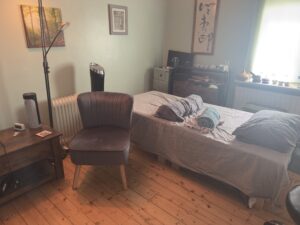Unwind tension. Unlock movement. Reclaim control.
For men who carry their stress in silence and their strain in stillness, Manual Release Therapy with James offers a powerful, hands-on approach to restoring balance in the body.
This treatment focuses on releasing deep muscular tension, fascial restriction, and postural holding patterns through highly skilled manual techniques. Whether you’re recovering from injury, living with chronic tightness, or simply feeling disconnected from your body, this therapy is designed to meet you where you are—and work with what your body needs.
Manual Release Therapy is a focused, anatomical approach to hands-on bodywork. James draws from a range of techniques—including myofascial release, deep tissue massage, trigger point therapy, positional release, and neuromuscular techniques—to assess and address the physical root of discomfort.
Unlike general massage, this is clinical, precise, and deeply personalised. It’s about understanding how your body holds tension, compensates, and moves—or doesn’t. And then helping it move better.


Over time, physical and emotional stress can become ‘stored’ in the body, leading to chronic tightness in areas such as the neck, shoulders, back, and hips. Manual Release Therapy uses precise, sustained pressure and soft tissue techniques to break these tension patterns—helping your body return to a more natural and relaxed state.
The fascial network—connective tissue that wraps around muscles and organs—can become stuck or bound, limiting mobility and creating pain. Through myofascial release, James helps to soften, hydrate, and decompress these restrictions, restoring natural glide and movement across joints and muscle groups.
Manual therapy can address muscular imbalances and compensatory holding patterns that affect alignment and posture. By releasing shortened or overactive muscles, joint mechanics are improved, and the body begins to hold itself with more structural integrity and less effort.
Many men live with low-grade, persistent pain from past injuries, manual labour, repetitive movements, or sedentary work. This treatment targets the soft tissue dysfunction underlying these issues—easing pain at its source rather than masking symptoms.
Whether you're lifting, training, or simply trying to move through the day with ease, restricted muscles limit your performance. Manual release techniques help re-establish functional length and elasticity within muscle groups, giving you back freedom of movement and improving resilience to future strain.
Following injury, scar tissue, inflammation, or protective muscular guarding can linger and affect performance. Manual therapy promotes healing by increasing circulation, breaking down adhesions, and encouraging safe re-engagement with movement. It’s particularly effective when paired with physiotherapy or structured rehabilitation programmes.
Though highly physical, the treatment has a regulating effect on the nervous system. Slow, sustained pressure and engaged presence activate the parasympathetic system, reduce cortisol levels, and help shift the body into a calmer, more responsive state—beneficial for those living with anxiety, hypervigilance, or trauma-related tension.
Manual Release Therapy invites you into a deeper relationship with your body. By identifying patterns of tension and movement dysfunction, James helps you become more attuned to the signals your body sends—empowering you to move, train, and rest with greater mindfulness and control.

BSc (Hons) Acupuncture PDip Applied Sports and Exercise Medicine
James Screeton is a qualified acupuncturist and somatic practitioner with a deep commitment to holistic, body-centred healing. Trained in Traditional Chinese Medicine and contemporary somatic approaches, James offers treatments that honour both the physical and emotional dimensions of wellbeing. His practice is grounded in attentiveness, compassion, and clinical precision, supporting individuals with issues ranging from musculoskeletal pain and stress to trauma and energy imbalance. With a calm and grounded presence, James creates a therapeutic space where people feel seen, supported, and empowered to heal.
with a warm, non-judgemental approach
designed for deep restoration
no two sessions are ever the same
Manual Release Therapy can be combined with acupuncture or naturopathic support if desired
James manual release therapy service offers a rare pause—a place where you can soften, recalibrate, and receive care without pressure or judgement.
in Nottingham’s Riverside Natural Health Centre
Booking your appointment is easy. Just click the button below to begin.
Men with chronic muscular tightness or movement restriction
Those recovering from injury or experiencing musculoskeletal pain
Gym-goers, athletes, or martial artists wanting to improve functional mobility
Desk workers or tradesmen with postural imbalances
Anyone who feels ‘stuck’ in their body or limited in their range
Your session begins with a brief postural or movement assessment and a discussion of your history—injuries, strain, daily demands, and goals.
Once on the table, James will use a combination of precise, hands-on release techniques, adapted in real-time to your body’s feedback. You’ll be asked for occasional input as tension points are explored—this is an interactive, collaborative therapy where your awareness is welcome.
Treatment is carried out with care and clinical integrity; you’ll undress to your comfort level and be appropriately draped throughout.
What is Manual Release Therapy?
It’s a specialised, hands-on treatment that focuses on releasing tension and restriction in muscles, fascia, and connective tissue. Drawing from clinical techniques such as myofascial release, trigger point therapy, and neuromuscular techniques, it’s ideal for addressing chronic pain, limited mobility, and postural imbalance.
Is it the same as massage?
Not quite. While both involve hands-on work, Manual Release Therapy is more targeted and clinical. It focuses on identifying specific areas of restriction and working with precision, rather than delivering a full-body relaxation experience. It may include static holds, slow pressure, or movement-based releases.
Will it be painful?
Some techniques may create discomfort—especially when releasing long-held tension or trigger points—but the pressure is always within your tolerance. James works slowly and communicates throughout to ensure the session remains effective and safe.
Do I need to undress fully?
You’ll only need to undress to your comfort level. Some techniques can be done through clothing or with partial draping. Towels or sheets are used at all times to preserve modesty and warmth.
What issues can this help with?
Manual Release Therapy is highly effective for muscular tightness, poor posture, reduced mobility, scar tissue restriction, chronic pain, tension headaches, and injury recovery. It’s also beneficial for anyone feeling disconnected or stuck in their body.
How many sessions will I need?
This depends on your goals. Some clients notice immediate improvements after a single session, while longer-term issues may require a series of treatments. James will give you honest feedback and can tailor a treatment plan if ongoing work is recommended.
Can I combine this with other therapies?
Absolutely. Manual Release Therapy pairs well with breathwork, acupuncture, naturopathy, or lifestyle coaching. If you’re addressing a specific concern—like postural dysfunction, trauma recovery, or training optimisation—James can collaborate with other therapists in the clinic.
Is it suitable after surgery or injury?
Yes, if you’ve been medically cleared to receive manual therapy. This treatment can help release scar tissue, reduce protective muscular guarding, and support long-term healing. Always share your medical history and any current concerns before treatment begins.
What will I feel like afterwards?
Most clients feel looser, lighter, and more mobile. Some experience mild soreness for 24–48 hours, particularly after deep work. You’ll be given aftercare advice and suggestions for movement or hydration to help support the integration process.

Putting Men First
Copyright © 2025. Bearded Bear Therapies is a trading name of Health Harmony Limited Reg company number 13871536